[EDITOR’S NOTE: The Biennial Project is immensely proud to be able to bring you this very thoughtful look into this biennial exhibit, written by our world-traveling correspondent Anne Murray.]
{
Photo credit Anne Murray, Museum of Modern and Contemporary Art of Oran
4th Mediterranean Biennial of Contemporary Art of Oran, Algeria
https://www.facebook.com/Biennaleoran
Interview by artist and participant Anne Murray, http://www.annemurrayartist.com , MFA and Master of Science in Theory, History, and Criticism of Art and Architecture, Pratt Institute, with the curators and co-founders of the Mediterranean Biennial of Contemporary Art of Oran, Algeria, Sadek Rahim, http://cloudconversations.weebly.com/sadek-rahim.html and President of Civ-Oeil Gallery Tewfik Ali Chaouche, http://www.civoeil.com/
July 2nd-31st, 2017
At the Museum of Modern and Contemporary Art of Oran (MAMO, Musée d'Art Moderne et Contemporain d'Oran )
With today’s mixture of classic and unconventional biennials, it is necessary to think again about the purpose and drive behind the biennial itself and to wonder where we are going globally in terms of art, its movements, and its connections to globalization.
This year’s Venice Biennale brought about many questions concerning the depth and political responsibilities of the biennial and its context. Viva Arte Viva seemed a bit superficial in terms of themes, although, yes, we all hope for Art to keep living and to remain strong in terms of significance and output around the world. It played a safe role in terms of not making anyone get too fussy about political titles, while subterfuge allowed some of the individual pavilions to give out unique passports and visas such as the Tunisian Freesa and the NSK pavilion passport. Although these ideas are not new, since it was Jorge and Lucy Orta who gave out Antarctica World Passports at the 9th Shanghai Biennale back in 2012, they are an indication that just beneath the surface or the superficial title, artists are still challenging the viewer and the world of politics.
Recently, such avant-garde approaches to the biennial format as the Museum of Non-Visible Art Biennial (MONA Biennial), the upcoming Wrong Biennial which combines digital pavilions with physical exhibitions around the world, and the Worldwide Apartment and Studio Biennial, have created a different context all together for the purpose and even, venue of a biennial in contemporary times.
The United States has seen a rise in interest in Islamic art with the displays at the Museum of Modern Art being changed over to represent Islamic art in the collection as a protest to travel bans, https://www.nytimes.com/2017/03/18/autossell/proposed-travel-ban-at-art-dubai-its-plainly-wrong.html, as well as the active collecting happening with the important Guggenheim UBS Map Global Art Initiative, https://www.guggenheim.org/map, which has expanded the collection to include more artists from South and Southeast Asia, Latin America, the Middle East and North Africa.
In Spain, the recent exhibit, Making Africa, showed at the CCCB, Center of Contemporary Art of Barcelona, http://www.cccb.org/es/exposiciones/ficha/making-africa/213052, and represented artists and designers from all over Africa, and was a more than subtle hint at the necessity of constructing a vision of Africa of the future through art. Still in Venice, we had a limited amount of representation from Africa and the diaspora with the Diaspora Pavilion, including some key emerging artists and mentor artists of influence from multiple diaspora, and the Nigerian (for the first time), Egyptian, and South African Pavilions.
So, what happens when someone decides to create a biennial that defies convention and is themed from the heart, refusing to indulge in the mass of political ambiguity and safe quadrants of benign titles and approaches, but instead, confronts directly the global issues of exodus? Well, the answer is, the Mediterranean Biennial of Contemporary Art of Oran, Algeria (Biennale Méditerranéenne d'art contemporain d'Oran), which is in its 4th edition this year.
Why is it important? How did it start? Well, considering that there has never been an Algerian Pavilion of Contemporary Art at the Venice Biennial, one realizes that its importance is tantamount in the contemporary art scene, in elevating and preparing the road to an Algerian Pavilion in Venice, in 2019 or 2021.
I asked the curators, Sadek Rahim and Tewfik Ali Chaouche, of the Mediterranean Biennial of Contemporary Art of Oran, Algeria, a few questions about its development, challenges, and the direction it is heading towards, in terms of creating a solid contemporary lift-off for Algerian artists and a pavilion in Venice for the future.
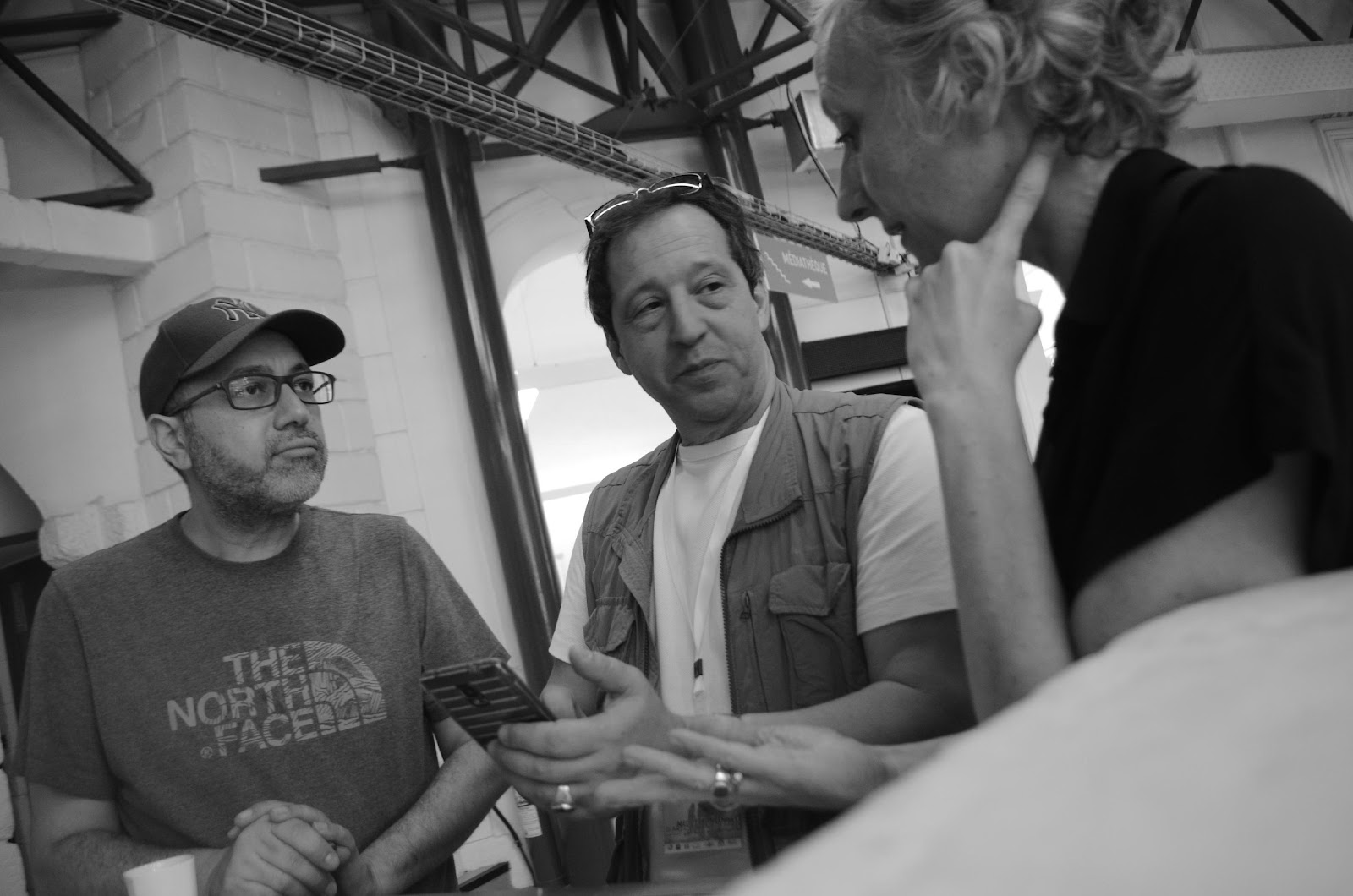
Photo credit Anne Murray, Curators Sadek Rahim (on the left), Tewfik Ali Chaouche, and journalist Stéphanie Pioda
Murray: What did you expect from artists who submitted work for the theme of Exodus?
Ali Chaouche: There were 37 Algerian artists and 20 foreign artists this year, hailing from England, Canada, Spain, France, Syria, Switzerland, Turkey, Tunisia, Palestine, the United States, Greece, Italy, and Thailand and the exhibition took place at the recently inaugurated, Museum of Modern and Contemporary Art of Oran. The participating artists who submitted their work for the theme of Exodus, were welcomed as a part of this project, because of their human and artistic engagement: as was stated in the open call for the theme, ‘Art is the mirror of society; it reflects one’s daily life- happiness and sadness.’ The works of these artists echo this reflection to the public, (of which, there were many visitors in the 4th Biennial)... for me, my objectives as a curator were to re-introduce contemporary art to the people of Oran who could not see and frequent exhibitions and visual art events for a long time except at the Civ-Oeil Gallery (www.civoeil.com), which shows contemporary art of Oran from time to time; there are no other visual art exhibition spaces in Oran and in the region for that matter.
Murray: Similarly to the early days of the Venice Biennale, I noticed that the biennial in Oran included a selection of invited artists, open call artists selected from around the world, and emerging Algerian artists, is this the way that the selection was made in the past or was it a new combination this year? Was there a particular reason why you made the grouping this way this time?
Ali Chaouche: Concerning the selection of artists, this year, we opted to have three invited artists (our choice was to have three contemporary Algerian artists who have been recognized recently for their creative productions and their diverse exhibitions across Algeria and abroad). The other artists who were chosen, represent all the different cities of Algeria, (the young creators), and some of the Mediterranean countries. We accepted some countries outside of the Mediterranean region, because of their relationship to the theme of Exodus. This year, since we had this particular theme of Exodus, our selections were made with this topic as a priority.
Murray: Sadek, what was your major role as a curator in this exhibition? I understand that you worked with several of the young artists helping them to develop their ideas, what can you share with us about this experience? In the Diaspora Pavilion in Venice, they paired more established artists with emerging artists, to help build and support the younger artists and their careers. Do you think this combination will be a new trend in biennial exhibitions? How do you see what you did in relation to the pairing of artists in the Diaspora Pavilion? As an established artist yourself, were you acting as curator and mentor to these young artists?
Rahim: What David A. Bailey and Jessica Taylor have done, as curators of the Diaspora Pavilion in Venice, and which is very interesting, is to create a pavilion structured as a project. They had the great idea to put out an open call for emerging British artists of various backgrounds in 2016. These young artists had not only to work for projects for the biennial, but also a two-year agenda of mentoring and support by a group of established artists. What we wanted to do at the Mediterranean Biennial of Contemporary Art in Oran, was a bit the same, except with regard to Algeria, there is a sense of urgency, because we are significantly behind in this area.
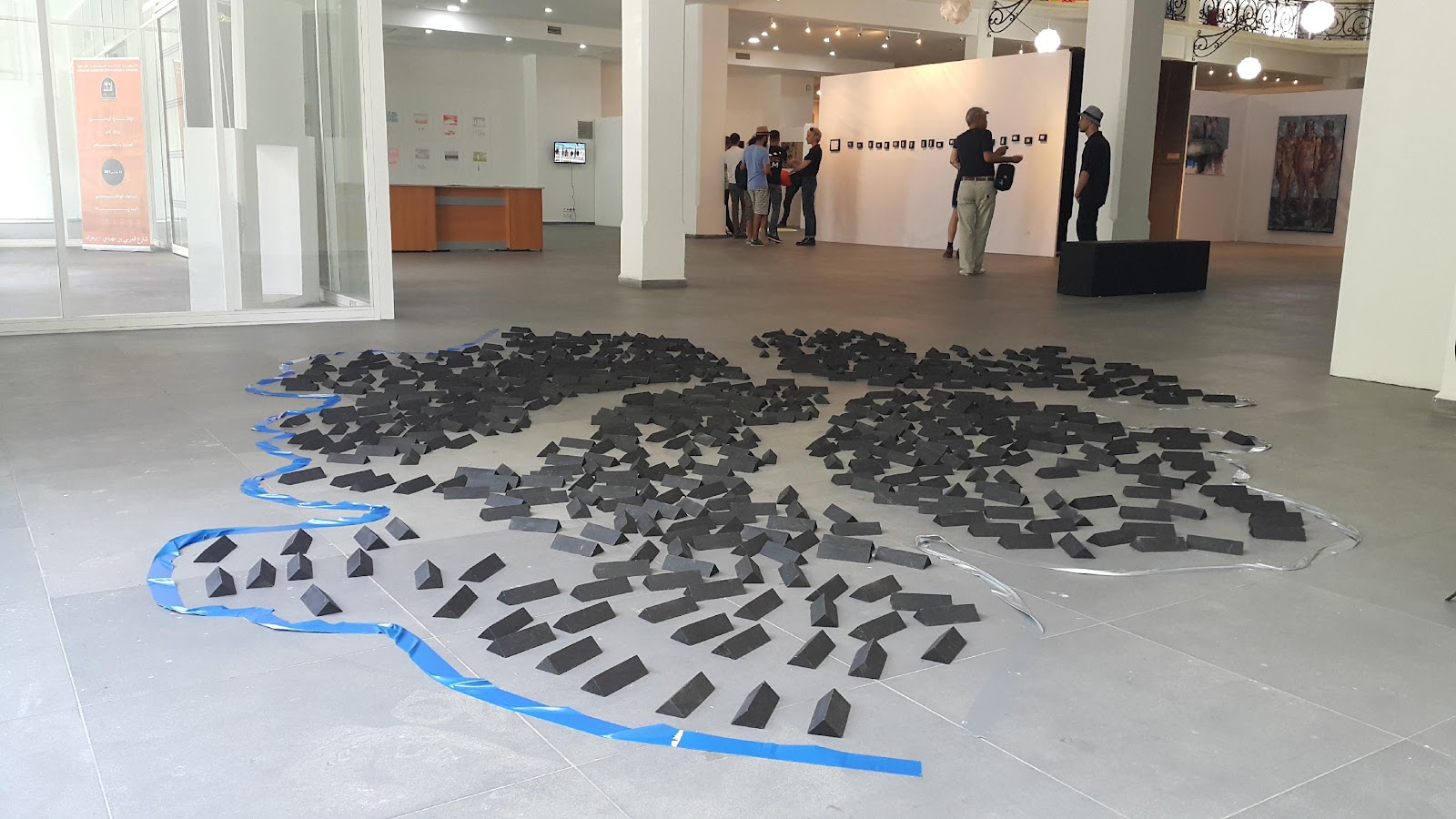
Photo credit Sadek Rahim, Camps, an installation by Djamel Benchenine
Rahim: The curatorial work with three young artists, which I had, was such a great experience for me as an artist and as a supporter of change in the cultural and academic programs of our country. These three young artists: Islem Haouti, Nora Zaïr, and Djamel Benchenine were such a good example of what we can do to help young artists to take a step forward. Djamel Benchenine had proposed at the end of my work with him, an installation 6/7 meters called ‘Camps’ a model of a Sahrawi refugee camp (Dakhla) in the city of Tindouf in Algeria. The artist made the tents of this camp out of wood, originally white, Djamel painted them in black, a color that reflects the tragedy of these peoples lives. In 2016, Djamel was invited as an artist to The International Film Festival of Western Sahara (Fisahara), which takes place at this camp among others and also, simultaneously, in Madrid, allowing for a greater number of personalities from the world of Spanish cinema, culture as well as Spanish citizens sympathizing with the Saharawi cause, and to the public in general, to attend and to inquire about the situation of the Saharawi refugees.
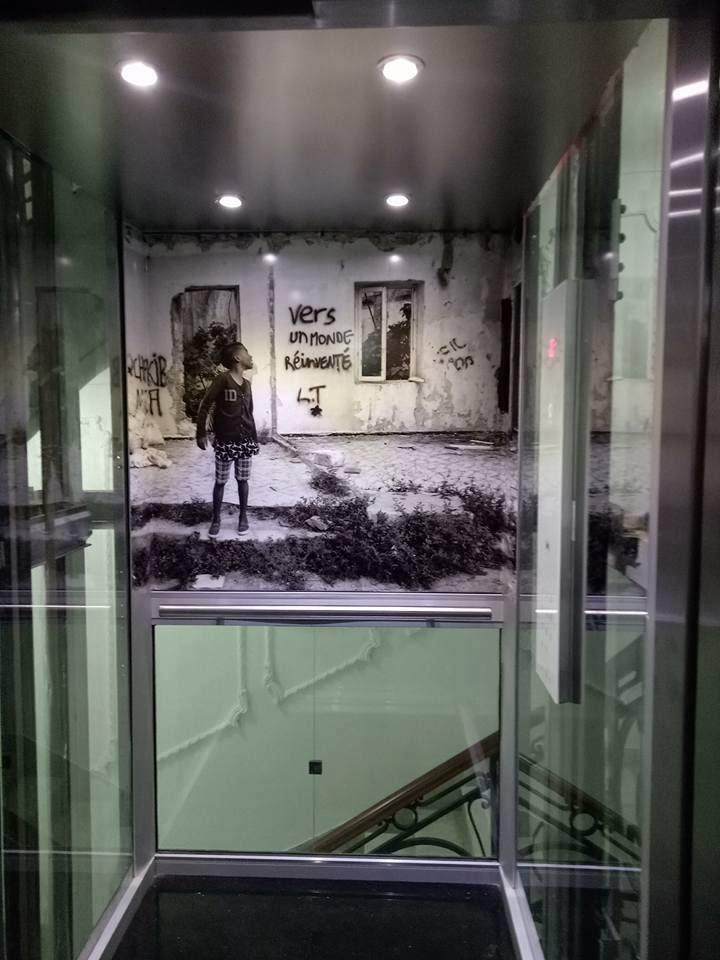
Photo credit Nora Zaïr, a photograph called, Up, by Nora Zaïr
Rahim: Nora Zaïr, photographer, worked on Rumi poetry. Rumi was one of the first who elaborated the ‘Sufi turning’ or the dervish dance, the physical exertions of movement, specifically dancing and whirling, in order to reach a state assumed by outsiders to be one of ‘ecstatic trances’ a way to travel ‘above’ to be closer to heaven. Her installation, a photograph ‘big sticker’ is glued to one of the panels of the museum elevator. Nora photographed a kid next to graffiti on a wall, which said ‘’towards a reinvented world”.
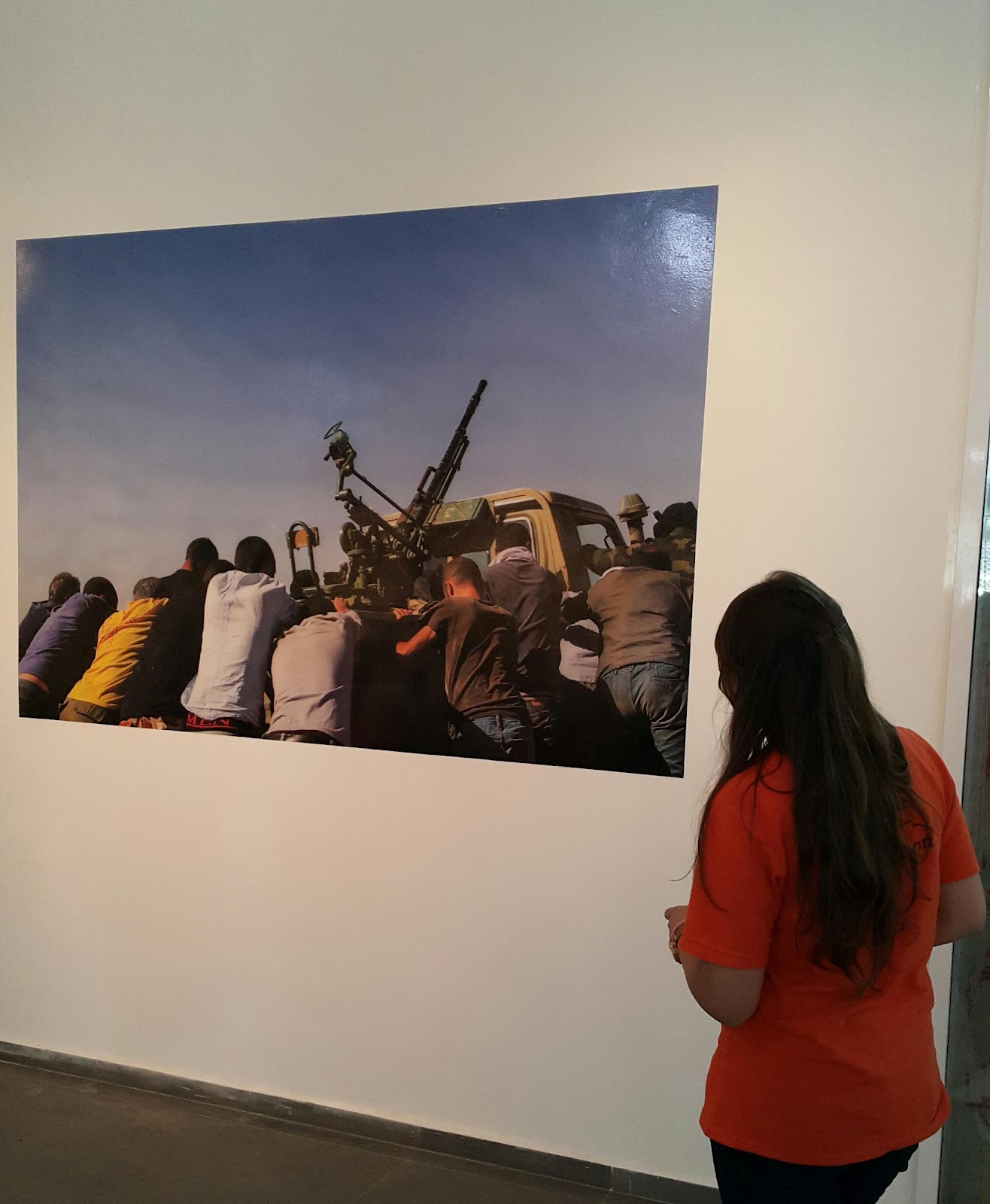
Photo credit Sadek Rahim, Freedom by Islem Haouti
Rahim: My work with photographer Islem Haouti was mostly about contemporary techniques and how to represent photography in a contemporary way. Islem chose to print a photograph called ‘freedom’ taken in the Western Sahara camps on a sticker and directly mounted it on one of the walls of the museum. The picture was taken when he worked with the Spanish human rights organization ARTifariti, inside a camp in the Western Sahara in 2016. And finally, yes, I think this combination should be a trend in the biennials, especially those of the Arab world and more precisely of the MENASA region (Middle East North Africa South Asia).
Murray: Who were the main jury members for the selection and what background do they have? Have they been involved with this biennial since the beginning?
Ali Chaouche: The principle members of the jury were : Sadek Rahim: artist (https://www.saatchiart.com/account/profile/90542)master’s laureate of the world-renowned, Central St. Martins University of the Arts in London, Co-curator and Co-Founder of the the Mediterranean Biennial of Contemporary Art of Oran, Hafid Boualem: Filmmaker and screenwriter (member of Civ-Oeil Gallery), Karim Benacef : Journalist (director of publication), Abdelhamid Aouragh : Photographer (journalist for Elkhabar ), Tewfik Ali Chaouche, President of the Jury: Artist (Co-Founder and President of the Mediterranean Biennial of Contemporary Art of Oran) During the 3rd and 4th Biennial, Tewfik Ali Chaouche was the curator representing Algeria in the Magmart International Videoart Festival. The members of the jury are all members of the Association of Visual Arts, Civ-Oeil and they have participated actively in the preparation of the 4th biennial. Of note,
I, myself, in the role of co-curator, consulted many professionals in the field of contemporary art, concerning the choices for the 4th biennial (outside of the jury itself) and with Sadek Rahim, we made a final selection taking into consideration the context of contemporary Algerian artists (integrating the works of some young emerging artists) who were included at the end with the selected artists.
Murray: What particularly surprised you about the submissions this year?
Ali Chaouche: This year, many artists surprised us with the context of their works :

Photo credit Djamel Benchenine, Installation, Exodus Cigarette by Djamel Benchenine
BENCHENINE Djamel, with his installation, Exodus Cigarette: this recent graduate of the Fine Arts School of Oran, made a connection with the younger generation of artists searching for liberty and discovery, he started by making graffiti on the walls of Oran (he draws, paints, and writes poetry to express himself and communicate a message) …with this installation, he delivers to us a strong and expressive message of Exodus in relation to cigarettes (youth smoke Kif or hashish for their specific Exodus)…through these drawings on cigarette papers, he tells us of the daily life of all youth who are forgotten in the shadows of the exodus of the cigarette (he cites 3 stages of the trip for young people : 1st trip towards God (with the worst and the best… to meditate), 2nd is a trip across Europe (immigration or exile), 3rd a trip through the cigarette papers (his drawings on these little translucent papers, but it’s also a trip into recklessness from the effects of hashish used to forget all of life’s daily problems).
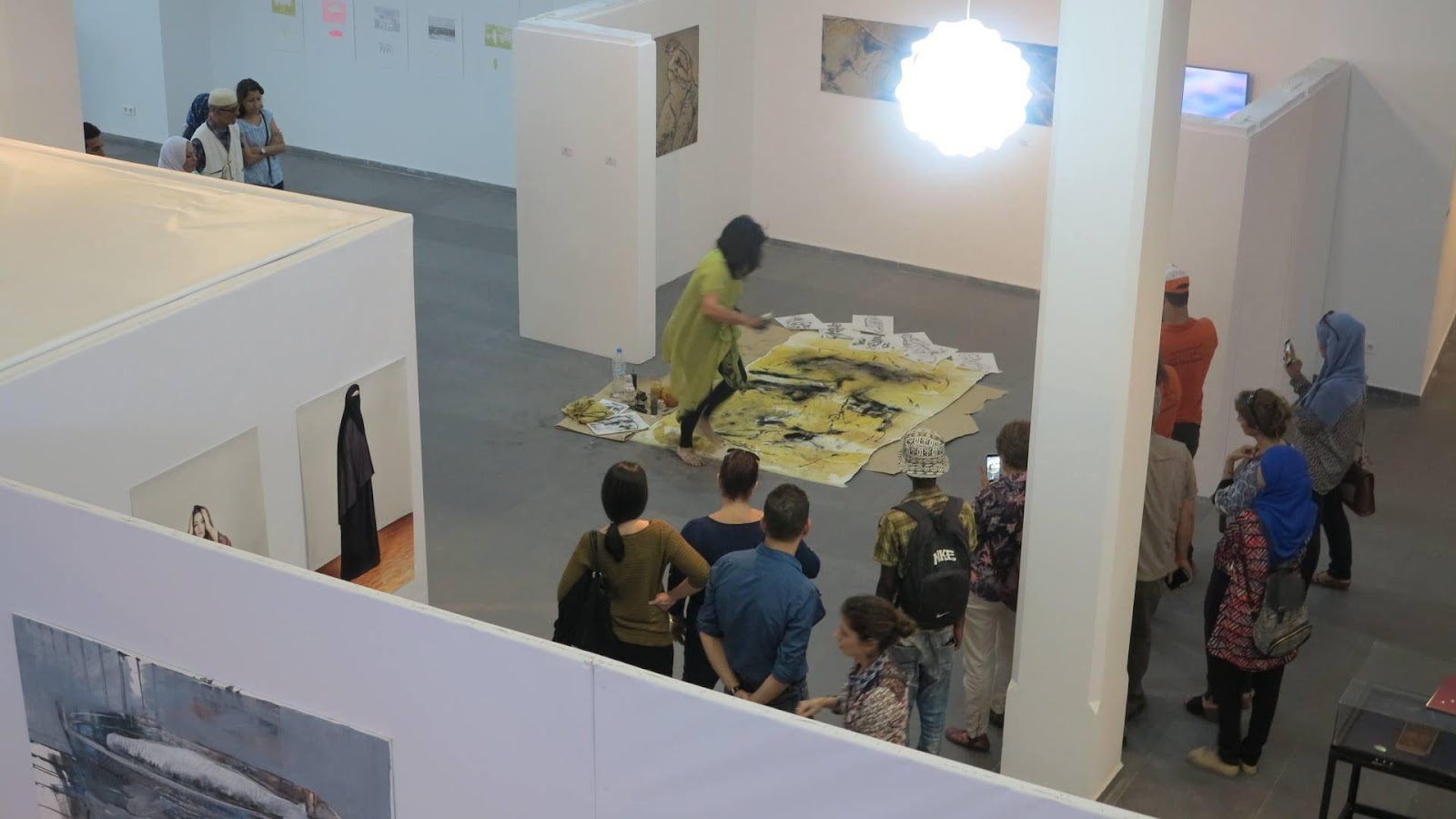
Photo credit Tewfik Ali Chaouche, artist Reyna (Renée Rey) performing Les Naufragés at the Mediterranean Biennial of Contemporary Art of Oran
Renée Rey (Reyna): This French artist is personally engaged in the theme with her performance art connecting photo-video and installation with paintings of drowned people, she presents to us a different way of participating in a biennial of contemporary art, where her way of sharing with the public of Oran engages the audience, quickly. Her section at the exhibition was the most visited and achieved the greatest interest and curiosity from the public.

Photo credit Sofiane Zouggar, Stories/Moving Objects by Sofiane Zouggar, www.sofianezouggar.com
Sofiane Zouggar : who made up part of the young contemporary Algerian artists, in this biennial, he presents his reflection in Exodus through a work entitled, Stories/Moving Objects, a beautiful story of a Syrian refugee from Aleppo, exiled to Algiers through the melodies of reed instruments that he makes and plays…this video shows us the drama of the Syrian Exodus from a different artistic angle with musical harmonies of the Ney (an oriental flute made of reeds)
Murray: Were there interpretations of the theme, Exodus, that were different than one would expect?
Ali Chaouche : Yes, there were some artists whose works interpreted the theme of Exodus in a very different way- that is what makes contemporary art so rich, the video art was more present in this biennial, which was a new thing for the MAMO
(Museum of Modern and Contemporary Art of Oran) which was, recently, inaugurated in March 2017 and did not always have the technical requirements for video projection.
One specific interpretation that caught our attention in terms of the technical and the artistic features, is without a doubt, your (Anne Murray) performance video, Exquisite Exodus. As an American artist, and global citizen, your work was quickly noticed for your beautiful performance video and photo installation highly enhanced by the technique and style of the interpretation of the theme of Exodus, which takes a dimension more psychological in the video accompanied by a narrative text … I see it as a professional work, which makes us proud to have you among the selected artists.

Photo credit Anne Murray
Exquisite Exodus by Anne Murray, watch the video here: http://www.annemurrayartist.com/exquisite-exodus.html (pictured above is fellow artist participant, Sihem Salhi, watching the video) www.annemurrayartist.com

Photo Credit Anne Murray, video Exquisite Exodus by Anne Murray
Murray: What were the last three biennials like? What venues? How many artists? How were they selected?
Ali Chaouche: The three previous biennials were at the Oran Cathedral (Médiathèque). The 1st Biennial theme was, Contemporary Art in Every State, and it took place from November 27-29, 2010. There were thirty artists who participated hailing from four countries, with 120 works of plastic art and 30 videos. We had 1200 visitors, and it was curated by HACHEMI AMEUR, Director of the Fine Arts School of Mostaganem.
The 2nd Biennial theme was, Young Contemporary Creation, and it was from March 29-31, 2012 with fifty artists, 15 were foreigners. We had 2 artists-in-residence: Samta Benyahia and Flaye. There were 3000 visitors and I was the curator. (Tewfik ALI CHAOUCHE, artist/painter –Founder and President of Civ-Oeil)
The 3rd Biennial theme was, The Other, and it was from June 8-10, 2014, also with 50 artists including 15 foreigners and we also had the same 2 artists-in-residence: Samta Benyahia and Flaye. We had less visitors that year because the timing was during the Baccalaureate exams, around 1500 visitors. We also has a an art intervention by the collective BOX 24 (Algiers) and had a video projection, a selection fo the international festival, Five. The curator was Karim SERGOUA (artist –teacher at the Fine Arts School).
Murray: What do you plan for the upcoming biennial?
Ali Chaouche: Everything depends on finances: if our association sustained financial support from the ministry of culture for this event it would have been different: We would have an open call to find an event agency that could create the programming for this international event a year in advance. We would choose 3 independent professional curators, with each proposing a different theme: 1 curator for the Algerian diaspora abroad, 1 curator to choose the local artists, 1 curator to choose the foreign artists. The biennial would extend to other spaces around the city of Oran and we would create a catalogue before the opening of the exhibition and other brochures to share around the city and to attract tourism. There would also be guided visits for students and scholars with mediators of contemporary art
Murray: How much do you think the venue and the support of the organizations involved has affected the outcome of the biennials of the past and the current biennial?
Ali Chaouche: Without a doubt, the place of exhibition and the support of state institutions plays a crucial role in the continuation of this art event: previously we had no financial support from the Ministry of Culture, and yet, thanks to various sponsors and partners, we were able to mount this biennial anyway (in the basement of the Mediateque (former Cathedral of Oran, which is currently empty). Now with the new Museum of Modern and Contemporary Art, the director is in favor of a partnership and so the financing for the next edition is open to possibilities and we have an optimistic vision for the future.
Murray: Tewfik, what do you as a curator and/or artist bring to the biennial that is unique?
Ali Chaouche: As the curator and artist founder of this biennial, I do everything I can with the organization, administration, and the making of the different exhibitions. There are multiple objectives for this biennial: to create a platform of contemporary art for exchange between artists of the Mediterranean region, also to create an Algerian art market in partnership with the international art market, to make the work of contemporary Algerian artists known internationally, to participate in the confrontation of some of the themes that unite us, and also to participate in the evolution of contemporary art in the Mediterranean region with conferences and round tables, as well as to create catalogues and brochures.
Murray: How do local artists feel about the Venice Biennial? Is it a goal to be represented there?
Ali Chaouche: The Venice Biennial remains the principal frame of reference for excellence for every artist in the Mediterranean region and, most certainly, for Algerian artists in their quest for international recognition, knowing full well that after having exposed their work in the ‘oldest biennial of the world’ its fame will move an artist further up the list of notoriety; some of the artists who have benefited from this recognition and opportunity are French-Algerians, who have had the opportunity to show in other national and curated pavilions, which are not labeled as Algerian, thanks to the help of their galleries, examples are Kader Atia and Adel Abdessemed.
Murray: Sadek, as an Algerian artist with growing distinction in the world, especially after your recent participation in Art Dubai, what are your thoughts and goals and are they related in any way to the Venice Biennial?
Rahim: Even though one’s chances are slim, with my gallery owner in Algiers, Amal Rougab, and the president of the Biennale of Oran, Tewfik Ali Chaouche, we are setting up a project and hoping that the Ministry of Culture will finally make a contribution to try to have a space in the next edition of the Venice Biennale. We are very motivated since for a very long time artists of Algerian origin participated in the Venice Biennial under so many other flags other than the Algerian one:Kader Attia, Zineb Sedira, Samta Benyahia… in 2015 Massinissa Selmani presented with curator Okwui Onwezor the project 'All the world's future' which had a ‘Special Mention’ during the 56th Biennale Of Venice.
Murray: What are some of the similarities and connections between Venice and Oran historically and in contemporary times?
Ali Chaouche: Oran and Venice are both Mediterranean cities, which have experienced a rich history of cultural and artisanal exchange since the time of the Ottoman empire, when the governor of Oran, Mohamed Kebir, employed some Venetian artisans for the decoration of his palace and vice versa, some Andalusian artisans from Oran, passed their knowledge and skills to Venice. From previous Venice Biennials, one has seen some connections made to Algeria- in the French pavilion, most notably with the architecture in the balconies of the architect Pouillon (from the period of colonization)…
Murray: What is it that attracts Algerian artists to the Venice Biennial, is there an interest in its connection to the art market?
Ali Chaouche: The Venice Biennial is the tipping point of contemporary art; it is of major importance in the world art market with its reputation and above all, it is the meeting place for art enthusiasts and collectors, from which stems, the interest of curators and Algerian gallerists to eventually have representation with an Algerian Pavilion in Venice.
Murray: How do you see the attraction of Algerians to the Venice Biennial and what are some of the issues related to the contemporary art scene in Algeria that you see manifesting themselves?
Rahim: Many artists leave Algeria because there is a great lack of galleries, museums, art fairs and above all the art market here is at its very infancy. Most of these artists leave the country for Europe or the USA, like Yazid Oulab, Massinissa Salmani or Adel Abdessemed. Artists who are still in the country bet on international events to show their work, to make a living and especially to prove to all the world that there is a consequent art production in the country. So, events such as the Venice Biennial are the ideal opportunity for Algerian artists to prove themselves and their very artistic existence.
Murray: The development of national pavilions has been a large part of the history of the Venice Biennial, how does that relate to Algeria historically and the desires of Algerian artists?
Rahim: In Algeria since its independence in 1962, protectionism, populism and above all nationalism are strict in the country; I wonder how the Algerian state resisted an opportunity like the Venice Biennial to show its power and greatness as is often done during military parades and other nationalist occasions.
Murray: What makes the biennial in Oran distinct from other biennials in the world?
Ali Chaouche: It’s the people and the city, who are open to Mediterranean cultures and to the world, the people are welcoming and curious about contemporary art. On the economic plane, Oran is the 2nd largest city in Algeria after the capital, with its oil port of Arzew and its industrial zone; it has been in a state of urban expansion since 2010 and there is an awareness of that it is still in an adolescent stage (Metro-with the formation of new networks of roads and urban spaces, etc.)… from this, the interest springs to create a new contemporary art space like the Museum of Modern and Conteporary Art of Oran, where the biennial is held this year, and for the work of the organizers of the creation of the network of art lovers and emerging collectors, businessmen like Mr. Dillali Merhi who owns a collection of Dinet, which he donated a part of to the Royal Hotel of Oran, an art space where many art enthusiasts who are investors in Oran in the domain of art and culture can meet up ; it is a city that flourishes day by day with its youth population very focused on new mediums of contemporary expression (photo, video, installation).
Murray: What makes this year’s biennial in Oran important?
Ali Chaouche: In our eyes, the 4th edition of the biennial in Oran is important because it confirms how unique this union of contemporary art of the Mediterranean is, unique because it is created by an artistic and cultural association (Civ- Oeil glalery). For this reason, one can not simply compare it to other biennials that are run by state authorities and ministries (where politics lays a hand on art). Also, another imporant element of the 4th edition